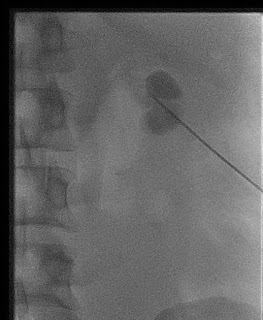Percutaneous nephrostomy is a technique in
which percutaneous access to the kidney is achieved under radiological
guidance. The access is then often maintained with the use of an indwelling catheter.
Indications
- Percutaneous nephrostomy is usually reserved for when retrograde approaches are unsuccessful or difficult. Clinical settings include: Urinary tract obstruction
- Urinary diversion (e.g. Ureteric injury; urine leak
- Access for percutaneous procedures (e.g. Stone treatment; Antegrade ureteric stenting)
- Diagnostic testing (e.g. Antegrade pyelography, Whitaker test)
Contraindications Absolute
contraindications
· Usually none
Relative contraindications
- Uncorrectable bleeding diathesis (abnormal
coagulation indices)
- Uncooperative patient
- Severe respiratory disease
Procedure
Pre-procedure evaluation
- Review all available imaging to confirm the indication for the procedure and assess renal anatomy and establish a safe access route to the kidney
- Check full blood count and coagulation profile to assess the risk of haemorrhage
- Obtain informed consent for the procedure
- Obtain good peripheral IV access
- Administer broad-spectrum IV antibiotics 1-4 hours prior to the procedure, if needed; septic patients are often already on parenteral antibiotics
Positioning
The procedure is performed with the patient in the prone,
prone oblique or lateral position, depending on clinical circumstances and
patient comfort. Regular monitoring of the vital signs by a suitably trained
staff member is recommended during the procedure. Clean skin with an antiseptic
solution and drape to maintain sterility for the procedure.
Equipment
- Ultrasound or fluoroscopy guidance
- Local anaesthesia with 1% or 2% lidocaine
- 18-gauge puncture needle, an alternative would be to use a micropuncture set with a 21- or 22-gauge needle
- 0.035-inch stiff guide wire (an 0.018 guide wire is also used with a micropuncture set)
- Water-soluble contrast media
- Dilators ranging from 7-9 French
- Pigtail drain (typically 8 French)
Technique
Two common techniques exist. The choice of technique depends on both operator and patient factors. One method utilizes a two- or three-part puncture needle and the other a micro-puncture kit. Using an aseptic technique and following infiltration of a local anaesthetic agent, the calyx (usually posterior calyx at the mid or lower pole) is punctured with an 18-gauge, two-part needle under ultrasound guidance. In the presence of renal tract obstruction, urine drains freely on the removal of the stylet from the needle.
A small volume
of water-soluble contrast
material can be injected to confirm the correct needle position using fluoroscopy. A 0.035 guide
wire is used to exchange
the needle for a dilator and
typically an 8 French pigtail drain is placed within the renal pelvis over the guide wire. On occasion,
a 6F or 12F catheter
may be used, on an individual case basis. A urine sample can be sent off to the laboratory for
microbiological studies. The catheter is left to drain freely.
Postprocedural care
Bed rest
(typically 2-4 hours) with regular monitoring of vital signs and provision of
adequate analgesia is routinely indicated in the first few hours following the
procedure. Fluid balance is regularly monitored, particularly in cases of
urinary tract obstruction. Indwelling nephrostomy catheters are usually
exchanged every three months.
It is essentially normal for the urine to be partly blood-stained for the first 48-
72 hours.
The patient should
take great care with the nephrostomy tube, to avoid malpositioning, despite
the internal pigtail of the locked drain, skin anchoring stitch and adhesive plaster.
Slippage is not uncommon but if the alerted medical staff is early,
nephrostomy salvage can be performed without
re-puncture.
Adequate hydration
can prevent early nephrostomy encrustation and obstruction. Nephrostomy
exchanges every 3 months are usually recommended.
Complications
- Bleeding
- Pneumothorax
- Bowel injury and peritonitis
- Urine leak
- Splenic or liver injury
- Catheter obstruction
- Catheter displacement - reported at ~20% after a few months
Nephrostomy drainage




